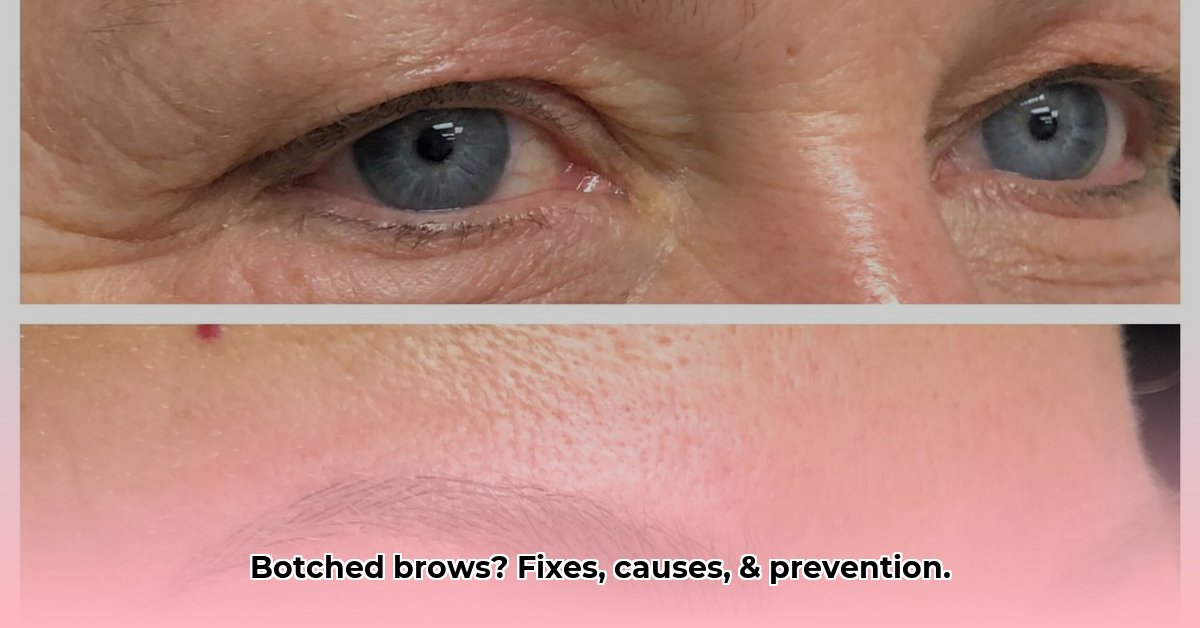So, you’re worried about bad microblading? You’re in the right place. This guide offers expert advice on avoiding, fixing, and moving forward from microblading mishaps. We’ll cover everything from recognizing the signs of a botched job to finding reputable correction specialists, empowering you to regain confidence in your brows.
What is Bad Microblading?
Bad microblading describes undesirable results from the procedure, often causing distress or self-consciousness. It can manifest in several ways, visually impacting the brows’ appearance. Let’s explore some common signs:
- Asymmetry: Eyebrows that are uneven in height, thickness, or shape. This can occur due to imprecise mapping or inconsistent application of pigment during the procedure.
- Incorrect Color: Pigment that’s too dark, too light, the wrong undertone, or has faded or changed color over time (like turning gray or blue). This suggests either poor pigment quality or a mismatch between your skin tone and the chosen color.
- Blurred or Migrated Pigment: Pigment spreading beyond the intended brow area, creating a smudged look. This can occur if the pigment is implanted too deeply or if there’s excessive bleeding during the procedure.
- Unnatural Shape: Brows that are disproportionate to your facial features – too thick, too thin, or with an overly arched or unnatural shape. This can be due to poor pre-procedure planning or a lack of artistic skill from the technician.
- Incorrect Placement: Brows positioned too high, too low, too close together, or too far apart, disrupting facial harmony. This suggests that the technician didn’t adequately map your brow placement to your face structure.
- Poor Stroke Quality: Strokes that are too thick, too long, too short, or inconsistent, resembling marker streaks rather than fine hairs. This suggests an inexperienced technician or improper technique.
- Scarring: Visible scarring in the brow area, suggesting excessive trauma to the skin during the procedure or during the aftercare process.
Why Does Bad Microblading Happen?
Several factors can contribute to unsatisfactory microblading results. Understanding these causes can help you make informed decisions and choose the right professional for your needs.
- Technician Inexperience: A technician lacking adequate training or experience can struggle with proper pigment selection, implant depth, stroke technique, and overall brow design.
- Low-Quality Pigments: Inferior pigments may fade unevenly, change color over time, or trigger allergic reactions.
- Unsanitary Practices: Non-sterile equipment or an unclean environment can lead to infections and complications.
- Improper Aftercare: Neglecting aftercare instructions can significantly impact healing and pigment retention, increasing the risk of undesirable results.
- Individual Skin Variations: Oily, dry, or sensitive skin types may react differently to the procedure and affect pigment retention. Some individuals may also be more prone to scarring or allergic reactions.
How to Fix Bad Microblading: A Step-by-Step Guide
If you’re dealing with bad microblading, there’s hope. Here’s a step-by-step guide to finding solutions:
Step 1: Consult a Specialist
Seek a highly reputable technician specializing in microblading corrections. Look for certified professionals with extensive experience correcting previous work and a strong portfolio.
Step 2: Explore Your Options
Discuss the following correction and removal methods with your specialist:
- Color Correction: Neutralizes unwanted pigment tones to achieve a more natural shade. This is suitable for correcting color imbalances but might not be effective for completely removing the pigment.
- Microblading/Microshading Touch-Up: Can refine shape, address minor asymmetries, or add density. This approach is ideal for addressing small imperfections but isn’t suitable for severe corrections.
- Topical Treatments: Specialized creams or gels can gradually lighten pigment. This is a less invasive option, but results can vary, and it may not completely remove the pigment. Some emerging research suggests certain topical treatments might accelerate pigment breakdown, but further studies are needed.
- Saline Removal: A saline solution lifts the pigment out of the skin. This is generally gentler than laser, but several sessions may be required and the procedure may be uncomfortable.
- Laser Removal (e.g., PicoWay): Laser energy breaks down pigment particles for removal by the body. This is often the most effective method for removing stubborn or migrated pigment, but it’s typically more expensive and requires multiple sessions.
- Microneedling/Micro-Needling: Tiny needles create micro-punctures in the skin to help break down pigment. This is a minimally invasive option but may require multiple sessions and involves some downtime. Research is ongoing to refine microneedling techniques for pigment removal.
- Surgical Removal: This is a last resort for significant scarring or extremely resistant pigment. While effective, it’s the most invasive option.
- Camouflage with Makeup: While not a permanent solution, makeup can conceal imperfections while exploring other options.
How to Avoid Bad Microblading: A Step-by-Step Guide
Preventing bad microblading is crucial. Follow these steps to minimize your risk:
Step 1: Research Thoroughly
Invest time in finding a qualified, experienced, and certified technician with a strong portfolio and positive reviews. Verify licenses and certifications.
Step 2: Schedule a Consultation
Discuss your desired brow shape, color, and overall aesthetic goals with the technician. Ask questions about their experience, techniques, pigment quality, and sterilization practices.
Step 3: Prioritize Hygiene
Ensure the technician adheres to strict hygiene and sterilization protocols.
Step 4: Follow Aftercare Instructions Meticulously
Proper aftercare is essential for optimal healing and pigment retention. Follow your technician’s instructions carefully, which may include:
- Keeping the Area Clean and Dry: Gently cleanse the brows with a mild cleanser and pat dry.
- Avoiding Sun Exposure: Use sunscreen and protective hats to prevent fading.
- Moisturizing: Apply a thin layer of recommended ointment or balm to keep the area hydrated.
- Resisting the Urge to Pick or Scratch: This can disrupt healing and cause scarring.
- Avoiding Certain Skincare Products: Retinoids, exfoliants, and harsh cleansers can interfere with healing and pigment retention.
Alternatives to Microblading
If you’re uncertain about microblading, consider these alternatives:
- Microshading: Creates a soft, powdered effect, resembling filled-in makeup.
- Powder Brows (Ombré Brows): A form of microshading that creates a gradient effect, with darker pigment at the tail of the brow and gradually lighter towards the front.
- Eyebrow Tinting: Temporarily dyes brow hairs for enhanced color and definition.
- Henna Brows: A natural dye that stains the skin and hairs for a semi-permanent tint, lasting a few weeks.
Frequently Asked Questions (FAQ)
- How much does microblading cost? Prices typically range from $400 to $1000, depending on location, artist experience, and the complexity of the procedure. Touch-ups usually incur an additional fee.
- Does microblading hurt? A topical numbing cream is typically applied before the procedure to minimize discomfort. Most describe the sensation as a mild scratching.
- How long does microblading last? Results typically last 12-18 months before needing a touch-up. Longevity can vary based on skin type, lifestyle, and aftercare.
Conclusion
Bad microblading can be disheartening, but it’s not the end of the world. By understanding the causes, prevention methods, and available correction options, you can regain confidence in your brows. Thorough research, choosing a qualified technician, and meticulous aftercare are key. If you encounter a problem, know that solutions exist. Don’t hesitate to seek professional advice. With careful planning and the right approach, achieving your desired brow aesthetic is within reach.
- Small Bento Box Makes Packing Lunch Easy and Fun Again - December 26, 2025
- Adult Bento Box Lunch Ideas For Quick Healthy Portable Options - December 25, 2025
- Adult Bento Meal Ideas for Delicious, Easy, and Healthy Lunches - December 24, 2025










